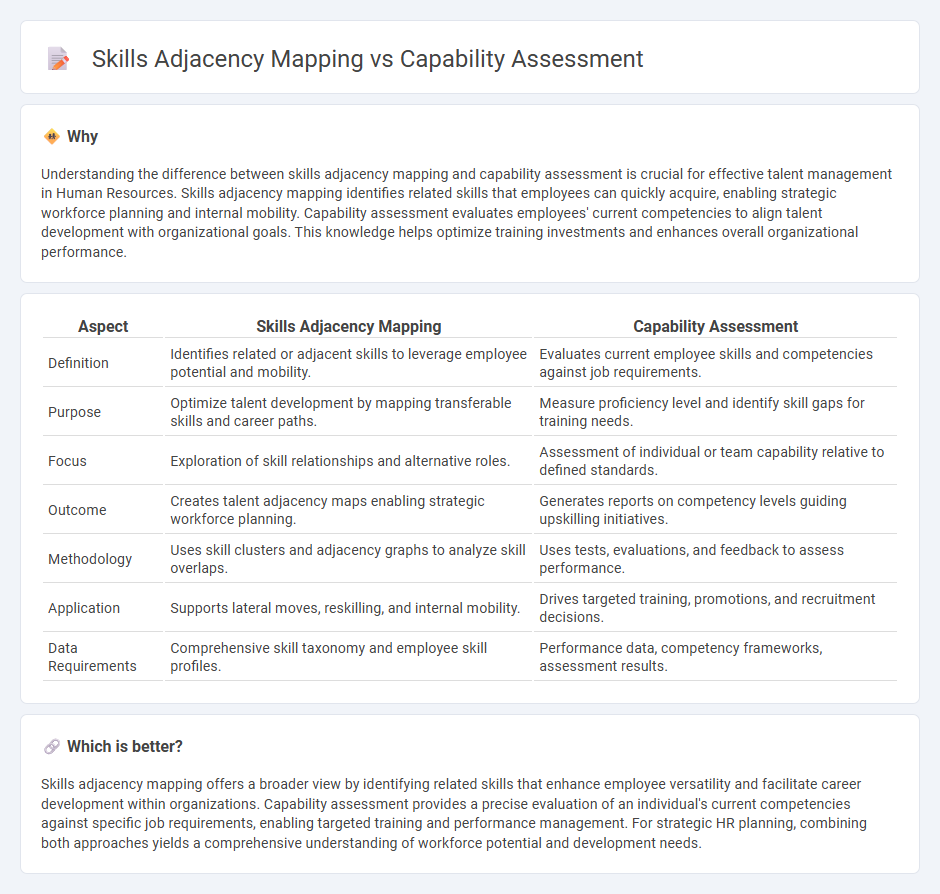
Skills adjacency mapping identifies and visualizes the relationships between closely related skills, enabling organizations to strategize employee development and internal mobility effectively. Capability assessment evaluates an individual's proficiency and potential to perform specific tasks, providing a detailed analysis of strengths and areas for improvement. Explore how integrating skills adjacency mapping with capability assessment can enhance talent management and workforce planning.
Why it is important
Understanding the difference between skills adjacency mapping and capability assessment is crucial for effective talent management in Human Resources. Skills adjacency mapping identifies related skills that employees can quickly acquire, enabling strategic workforce planning and internal mobility. Capability assessment evaluates employees' current competencies to align talent development with organizational goals. This knowledge helps optimize training investments and enhances overall organizational performance.
Comparison Table
| Aspect | Skills Adjacency Mapping | Capability Assessment |
|---|---|---|
| Definition | Identifies related or adjacent skills to leverage employee potential and mobility. | Evaluates current employee skills and competencies against job requirements. |
| Purpose | Optimize talent development by mapping transferable skills and career paths. | Measure proficiency level and identify skill gaps for training needs. |
| Focus | Exploration of skill relationships and alternative roles. | Assessment of individual or team capability relative to defined standards. |
| Outcome | Creates talent adjacency maps enabling strategic workforce planning. | Generates reports on competency levels guiding upskilling initiatives. |
| Methodology | Uses skill clusters and adjacency graphs to analyze skill overlaps. | Uses tests, evaluations, and feedback to assess performance. |
| Application | Supports lateral moves, reskilling, and internal mobility. | Drives targeted training, promotions, and recruitment decisions. |
| Data Requirements | Comprehensive skill taxonomy and employee skill profiles. | Performance data, competency frameworks, assessment results. |
Which is better?
Skills adjacency mapping offers a broader view by identifying related skills that enhance employee versatility and facilitate career development within organizations. Capability assessment provides a precise evaluation of an individual's current competencies against specific job requirements, enabling targeted training and performance management. For strategic HR planning, combining both approaches yields a comprehensive understanding of workforce potential and development needs.
Connection
Skills adjacency mapping identifies related competencies that enhance workforce versatility, while capability assessment evaluates the proficiency levels of employees in these competencies. Integrating both tools enables organizations to pinpoint skill gaps, optimize talent development, and align employee abilities with strategic business goals. This connection supports targeted training programs and effective succession planning within Human Resources management.
Key Terms
Competency Evaluation
Capability assessment measures an individual's ability to perform tasks based on knowledge, skills, and behaviors, while skills adjacency mapping identifies related competencies that complement or enhance existing skills. Competency evaluation integrates these approaches to provide a comprehensive analysis of strengths and gaps in workforce capability, driving targeted development and strategic talent management. Explore how combining these methodologies can optimize employee growth and organizational performance.
Skill Gap Analysis
Capability assessment identifies the organization's overall strengths and weaknesses by evaluating competencies across roles, while skills adjacency mapping highlights related skills that employees can acquire to bridge skill gaps efficiently. Skill gap analysis leverages both methods to pinpoint missing capabilities and guide targeted training, ensuring workforce alignment with strategic goals. Explore how integrating these techniques optimizes talent development and drives business success.
Talent Mobility
Capability assessment identifies current employee competencies to match job requirements, enabling targeted development within talent mobility programs. Skills adjacency mapping reveals related skills employees can acquire easily, facilitating smoother internal transitions and upskilling pathways. Explore how integrating these methods enhances workforce agility and drives strategic talent mobility.
Source and External Links
The How-to Guide to Effective Capability Assessment - Offers a structured framework for evaluating job seekers' and employees' capabilities, utilizing tools like interviews and self-assessments to identify proficiency levels and areas for improvement.
Capability Assessments - Discusses capability assessments as tools to measure workforce expertise and guide business transformation by identifying strengths, weaknesses, and areas for growth.
What is Workforce Capability Assessment? - Explains workforce capability assessment as a systematic process to evaluate skills, knowledge, and competencies to meet current and future business needs effectively.
 dowidth.com
dowidth.com